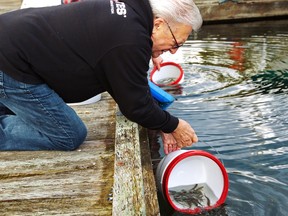UBC researchers collaborated with Mossom Creek Hatchery in Port Moody to track the salmon and find out why they were dying near the release site.

Article content
Researchers from the University of British Columbia have partnered with Mossom Creek Hatchery in Port Moody to track thousands of juvenile coho salmon and find out why they are declining.
Last year, they used acoustic telemetry to monitor transmitter-tagged coho as they traveled across the ocean. And what they found was that about 60 percent of the 90 tagged coho released into Burrard Inlet were probably eaten by predators. three kilometers from the release point.
Advertisement 2
Article content
Article content
“Then it was a gradual decline. … I think there were 15 to 25 per cent of the fish left when they got to the Lions Gate Bridge,” said Scott Hinch, who directs UBC’s Pacific Salmon Ecology and Conservation Laboratory.
Now researchers want to know if releasing juvenile coho in different locations will increase their survival levels. They will also include release testing directly into Mossom Creek.
Although the low numbers didn’t surprise Hinch because he had seen this in other studies, he said it was a bit of a shock to the volunteers at the hatchery.
“And so we suggested that if we could change the release location, maybe a little further west… we could experiment and compare the different release sites,” he said.
“I think there was an element of trying to establish the career in a more natural way. “We don’t know if this is going to work, but that’s why we’re doing this experiment.”
On Tuesday, Kevin Ryan, president of the hatchery, was working with volunteers to tag his coho. Unlike the first experiment, where they could only afford to tag 90 fish with expensive transmitters, they are now tagging all 4,000 juvenile coho using a more economical method that uses passive integrated transponders, or PIT tags, which require no power. and instead it uses a microchip that is activated when it passes through an antenna.
Article content
Advertisement 3
Article content
“We’re tagging about 1,000 a day,” Ryan said. He The Mossom hatchery releases between 5,000 and 10,000 coho smolts each year, and is one of the few hatcheries that releases coho directly into the ocean, according to UBC.


He knew that the juvenile coho they release face enormous challenges from predators, but he was surprised that so few of them made it out of the eastern part of Burrard Inlet.
“Seals are very smart, they see people and they know we’re releasing fish, so they’re just waiting,” Ryan said.
A few years ago, Ryan called Hinch at UBC to ask if he would consider doing some research at his Port Moody hatchery. He said Hinch was very open to the idea of conducting experiments.
“He said, ‘we could do telemetry monitoring to see how the fish are leaving the inlet,’ and I thought that was a great idea. So we raised some money, but it wasn’t a cheap experiment. “It was $40,000.”
Ryan said the five-year study will provide invaluable information for Mossum volunteers to understand where the best places are to release them and increase salmon returns.
Advertisement 4
Article content
“We do a very good job as a hatchery. We get the eggs and we take care of them and we raise them into fry and smolts and then we release them and we have a 95 to 99 percent success rate. So we have a lot of success in that part, but then we put them all in this big black box and we’re not really sure what happens. So what we’re trying to do is use science, technology and research to solve it,” Ryan said.
“The partnership with Scott, his lab and his students has worked very well.”
Hinch said salmon runs continue to decline and it’s important that volunteer-run hatcheries like Mossom continue to find ways to help these fish survive.
“High mortality of juvenile salmon is typical during this phase of life. “It’s a natural phenomenon,” Hinch said. “It is a challenge for all hatcheries that release fish in BC”
Findings to date They are published in the North American Journal of Fisheries Management.
Article content
